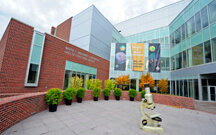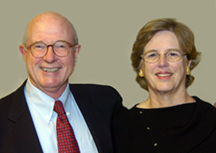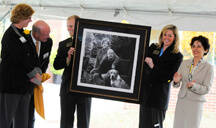
| RELATED WEB SITES |
| * Hockmeyer Hall |
| * Science Women for Purdue |
| RELATED VIDEOS |
| * Hockmeyer Hall |
| * Michael Rossmann Lab |

October 2, 2009
Purdue dedicates Hockmeyer Hall of Structural Biology
WEST LAFAYETTE, Ind. - |
The Wayne T. and Mary T. Hockmeyer Hall of Structural Biology was dedicated Friday (Oct. 2). The building, which houses the Markey Center for Structural Biology, is located adjacent to Discovery Park at Harrison Street and Martin Jischke Drive.
Purdue structural biologists were the second in the world to map a virus, the first to map the common cold virus and continue to provide breakthroughs that could lead to better drug delivery and treatments of diseases such as cancer. This will be the first move for the group since it began its work in the basement of Lilly Hall 45 years ago.
"The contributions to fundamental science and medicine made by Purdue's structural biology group are unsurpassed," Purdue President France A. Córdova said. "This building will enhance the facilities and elevate the group's research efforts. It also significantly strengthens Indiana's reputation as a leader in the life sciences. The basic discoveries made here will be translated into the creation of new companies and new ways to combat infectious disease and potential pandemics."
 |
The $32.9 million, 65,690-square-foot building is named for Wayne T. Hockmeyer and his wife, Mary, who gave $5.3 million toward its construction.
"Structural biology is the cornerstone of the new era of biological sciences," said Wayne Hockmeyer, a Purdue alumnus and founder of biotechnology company MedImmune. "It has expanded into new fields, such as nanomedicine, in its investigation of widespread and devastating diseases. This building reflects that expansion as structural biologists will now be neighbors with biomedical and nanotechnology engineers."
The building includes eight specialized labs and eight general labs for work in the areas of protein production, cell and virus culture, large-molecule crystallization, X-ray diffraction, nuclear magnetic resonance spectroscopy, electron microscopy, and analytical and biophysical instrumentation. The building also includes a state-of-the-art containment laboratory with a dedicated electron microscope so that researchers can examine a broader range of viral agents.
In addition, the building houses 16 offices for structural biology faculty, 33 offices for students and staff, and three conference rooms.
 |
"Purdue's structural biology team has been very successful in the past, and these first-class facilities will advance its current research capabilities and future prospects by providing space for state-of-the-art equipment and enhanced recruitment of students, postdoctoral researchers and faculty," said Jeffrey Roberts, the Frederick L. Hovde Dean of the College of Science. "It is important to note that history has been made not only by the researchers, but also by the groups that support them. The Science Women for Purdue alumnae group became the first group of women in Purdue's history to raise funds for a named space on campus through its gift to Hockmeyer Hall."
The Science Women for Purdue gave $300,000 for the project and the new electron microscopy laboratory is named in the group's honor.
Purdue's structural biology group has four electron microscopes, two of which are advanced high-end cryoelectron microscopes that allow researchers to see nearly down to the molecular level.
In addition, a new $4 million Titan cryoelectron microscope will be installed thanks to a grant from the National Institutes of Health. The FEI Titan Krios microscope, the most advanced electron microscope currently available, has accessories that permit examination of frozen hydrated samples, an energy filter to improve tomograms, and an automatic loading device that eliminates the need for a technician to be present during each sample change. It is capable of running for days without human contact. Scientists can remotely operate and monitor it from the "visualization room," the control center of the new facility.
Each microscope requires carefully controlled environmental conditions and takes up a small room.
This large equipment is necessary to see the tiny elements of life - molecules and atoms - that structural biologists study. Seeing the structure of the basic building blocks of biological materials illuminates how they work and provides a greater understanding of biological processes, said Richard Kuhn, head of the Department of Biological Sciences.
"This building is designed for efficiency, interaction and function," said Kuhn, who also is the Gerald and Edna Mann Director of the Bindley Bioscience Center. "Having all of the instrumentation in close proximity allows the group to perform research more efficiently, easily collaborate and branch out into new techniques."
The high-end equipment and facilities, along with increased collaboration, will allow the full potential of one of Purdue's most internationally renowned research groups to be tapped, Kuhn said.
"Hockmeyer Hall could lead Purdue to new breakthroughs in understanding how important groups of human viruses function and infect cells," he said. "Also, we are well positioned to advance the investigation of cell membrane proteins - the gateways into and out of cells that are key to drug delivery."
The facility was made possible by more than $17 million in gifts.
The Hockmeyers of Vero Beach, Fla., both grew up in Evansville, Ind. Wayne Hockmeyer earned his bachelor's degree in entomology from Purdue in 1966 and his doctorate from the University of Florida in 1972. Purdue awarded him an honorary doctorate in 2002. He returned that same year to participate in the Old Master's program, which allows current Purdue students to interact with past graduates to gain perspective on confronting challenges in their careers. Mary Hockmeyer earned her bachelor's degree in liberal arts from Indiana University, master's degree in gifted education from George Washington University and her doctorate in human development from the University of Maryland in 1990.
After three months in his first job at Dow Chemical Co. in Michigan, Wayne Hockmeyer was commissioned in the Army, and, following airborne and Special Forces training, was sent to Vietnam in 1968 with the 5th Special Forces Group. The Army assisted with Hockmeyer's return to the University of Florida, where he earned his doctorate. He rose to the rank of lieutenant colonel and, during his 20-year military career, authored many research papers with particular emphasis on the development of malaria vaccines. He also was awarded the Legion of Merit, Bronze Star, Meritorious Service medal and the Army Commendation medal. The Legion of Merit and Meritorious Service medals were each separately awarded twice. He concluded his military career as chief of the Department of Immunology at the Walter Reed Army Institute of Research in 1987.
Hockmeyer founded the biotechnology company MedImmune Inc. in 1988 and served as its CEO until October 2000.
Hockmeyer was elected to serve on MedImmune's board of directors in 1988. He was elected chairman of the board in 1993 and remained in that position until 2007. The company developed and now markets Synagis®, an FDA-approved monoclonal antibody to prevent an infectious disease, and FluMist®, a live attenuated intranasal influenza vaccine. In 2006 MedImmune generated more than $1 billion in annual revenue and invested more than $438 million in research and development. The company has approximately 3,000 employees worldwide and was acquired by AstraZeneca plc in June 2007 for approximately $15.6 billion.
Hockmeyer also served as president of MedImmune Ventures Inc., the company's venture capital subsidiary, which was launched in 2002. He serves on the boards of directors of several public companies, including Baxter International Inc., GenVec Inc. and Idenix Pharmaceuticals Inc.
Mary Hockmeyer taught school in California; Florida; Nairobi, Kenya; and Maryland where she worked with highly gifted children. She and Wayne also support Guiding Eyes for the Blind in Yorktown Heights, N.Y., which provides guide and service dogs. It also is the first guide dog school to provide safety and therapeutic companionship for children with autism.
Writer: Elizabeth Gardner, 765-494-2081, ekgardner@purdue.edu
Media contact: Judith Barra Austin, 765-494-2432, jbaustin@purdue.edu
Sources: France A. Córdova, president@purdue.edu
Jeffrey Roberts, 765-494-1730, jtrob@purdue.edu
Richard Kuhn, 765-494-4407, kuhnr@purdue.edu
Purdue News Service: (765) 494-2096; purduenews@purdue.edu
PHOTO CAPTION:
Mary and Wayne Hockmeyer (at left) and Purdue President France A. Córdova (far right) look over a portrait of the Hockmeyers being held by Matt Bartlett and Sheila Miller, members of the Purdue Foundation Student Board. The portrait, which was unveiled Friday (Oct. 2) at the dedication of the Wayne T. and Mary T. Hockmeyer Hall of Structural Biology, will hang in the facility. (Purdue University photo/Andrew Hancock)
A publication-quality photo is available at https://www.purdue.edu/uns/images/+2009/hockmeyer-dedication.jpg
To the News Service home page
